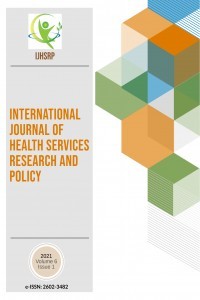THE STUDY OF THE LONG-LIVERS DYNAMICS IN THE POPULATIONS OF ADJARA IN 2012-2017
THE STUDY OF THE LONG-LIVERS DYNAMICS IN THE POPULATIONS OF ADJARA IN 2012-2017
longevity, centenarian, long-liver, aging,
___
- [1]. Sanderson WC, Scherbov S. “Average remaining lifetimes can increase as human populations age”, Nature, 435, 811–813, 2005. doi: 10.1038/nature03593 [PubMed] [2]. Sanderson WC, Scherbov S. “The characteristics approach to the measurement of population aging” Popul Dev Rev.,39, 673–685, 2013. doi: 10.1111/j.1728-4457.2013.00633.x [3]. Chucks, J (July 2010). "Population Ageing in Ghana: Research Gaps and the Way Forward". Journal of Aging Research, 1,8,2010. doi:10.4061/2010/672157. [4]. World Population Ageing: 1950-2050, United Nations Population Division. [5]. Instituto Nacional de Estat´ıstica, “Populac¸˜ao residente por Local de residˆencia, Sexo e Grupo et´ario (Decenal),” http:// www.ine.pt/xportal/xmain?xpid=INE&xpgid=ine indicadores& amp; indOcorrCod = 0006368& amp; contexto=bd& selTab=tab2. [6]. L. Poon and S. Cheung, “Centenarian research in the past two Decades,” Asian Journal of Gerontology &Geriatrics, 7, 13, 2012. [7]. R. M. Afonso, O. Ribeiro, M. V. Patto, M. Loureiro, M. J. Loureiro, M. Castelo-Branco, S. Patrício, S. Alvarinhas, T. Tomáz, C. Rocha, A. M. Jerónimo, F. Gouveia, A. P. Amaral, "Reaching 100 in the Countryside: Health Profile and Living Circumstances of Portuguese Centenarians from the Beira Interior Region Hindawi”, Current Gerontology and Geriatrics Research, 2018, Article ID 8450468, 11 pages https://doi.org/10.1155/2018/8450468 [8]. H. Engberg, A. Oksuzyan, B. Jeune, J. W. Vaupel, and K. Christensen, “Centenarians - A useful model for healthy aging? A 29-year follow-up of hospitalizations among 40000 Danes born in 1905,” Aging Cell, 8(3), 270–276, 2009. [9]. C. Darviri, P. Demakakos, F. Charizani et al., “Assessment of the health status of Greek centenarians,” Archives of Gerontology and Geriatrics, 46(1), 67–78, 2008. [10]. M. Motta, L. Ferlito, S. U. Magnolfi, et al., "Cognitive and functional status in the extreme longevity," Archives of Gerontology and Geriatrics, 46(2), 245–252, 2008. [11]. T. T. Perls, K. Bochen, M. Freeman, L. Alpert, and M. H. Silver, “Validity of reported age and centenarian prevalence in New England,” Age and Ageing, 28(2),193–197, 1999. [12]. B. J. Willcox, D. C. Willcox, and L. Ferrucci, “Secrets of healthy aging and longevity from exceptional survivors around the globe: Lessons from octogenarians to supercentenarians,” The Journals of Gerontology. Series A, Biological Sciences andMedical Sciences, 63(11), 1181–1185, 2008. [13]. D. Jopp and C. Rott, “Adaptation in very old age: Exploring the role of resources, beliefs, and attitudes for centenarians’ happiness,” Psychology and Aging, 21(2), 266–280, 2006. [14]. S. M. Samuelsson, B. Bauer Alfredson, B. Hagberg, et al., "The Swedish Centenarian Study: A multidisciplinary study of five consecutive cohorts at the age of 100," International Journal of Aging and Human Development, 45(3), 223–253, 1997. [15]. T. Koch, R. Turner, P. Smith, and N.Hutnik, “Storytelling reveals the active, positive lives of centenarians,” Nursing Older People, 22(8), 31–36, 2010.
- Yayın Aralığı: Yılda 3 Sayı
- Başlangıç: 2016
- Yayıncı: Rojan GÜMÜŞ
FRAILTY AMONG THE BENEFICIARIES OF BATUMI ST. CATHERINE NURSING HOME
Rusudan KHUKHUNAİSHVİLİ, Marina Koridze KORIDZE, Kristine Makharadze MAKHARADZE, Sophiko Tskvitinidze TSKVITINIDZE, Marina Nagervadze NAGERVADZE, İrina Nakashidze NAKASHIDZE, İrakli PARULAVA
THE STUDY OF THE LONG-LIVERS DYNAMICS IN THE POPULATIONS OF ADJARA IN 2012-2017
Marina KORİDZE, Rusudan KHUKHUNAISHVILI, Temur KARTSIVADZE, Sophiko TSKVITINIDZE, İrina NAKASHIDZE, Kristine MAKHARADZE
Bahar KARTAL, Mehmet Tahir HATİPOĞLU, Ümit Ali KAYIŞLI, Sevtap HAMDEMİR KILIÇ, Evrim ÜNSAL, Candan ÖZOĞUL
JOB SATISFACTION AS AN OBJECTIVE INDICATOR OF WORK MOTIVATION AMONG INTENSIVE CARE UNIT (ICU) NURSES
Dejan ŽİVANOVİĆ, Jovan JAVORAC, Branislava BRESTOVAČKI SVITLICA, Svetlana STOJKOV
CARRIERS OF CHROMOSOME TRANSLOCATIONS FROM THREE MEN WITH AZOOSPERMIA
Gülbahar GÜZEL ERDAL, Mahmut BALKAN
Necmettin ÇİFTÇİ, Sonay BİLGİN
Yusuf NERGİZ, Engin DEVECİ, Muhammet Erdal SAK, Mehmet Sıddık EVSEN, Cenap EKİNCİ, Sebnem NERGİZ, Beyza KARADEDE UNAL, Ugur SEKER
